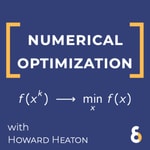Numerical Optimization – Détails, épisodes et analyse
Détails du podcast
Informations techniques et générales issues du flux RSS du podcast.


Classements récents
Dernières positions dans les classements Apple Podcasts et Spotify.
Apple Podcasts
🇺🇸 États-Unis - mathematics
08/08/2025#90🇺🇸 États-Unis - mathematics
07/08/2025#91🇺🇸 États-Unis - mathematics
06/08/2025#90🇺🇸 États-Unis - mathematics
05/08/2025#87🇺🇸 États-Unis - mathematics
04/08/2025#87🇺🇸 États-Unis - mathematics
03/08/2025#86🇺🇸 États-Unis - mathematics
02/08/2025#83🇺🇸 États-Unis - mathematics
01/08/2025#80🇺🇸 États-Unis - mathematics
31/07/2025#76🇺🇸 États-Unis - mathematics
30/07/2025#74
Spotify
Aucun classement récent disponible
Liens partagés entre épisodes et podcasts
Liens présents dans les descriptions d'épisodes et autres podcasts les utilisant également.
See allQualité et score du flux RSS
Évaluation technique de la qualité et de la structure du flux RSS.
See allScore global : 43%
Historique des publications
Répartition mensuelle des publications d'épisodes au fil des années.
Welcome to Numerical Optimization
vendredi 15 novembre 2024 • Durée 01:00
Our mission is to inspire the development of new math research aimed at solving real-world problems. We do this by sharing fun stories behind math formulas and the places they show up.
#1 — Stanley Osher
Épisode 1
lundi 25 novembre 2024 • Durée 30:27
Stanley Osher is a mathematician at University of California Los Angeles.
Subscribe for updates and related optimization articles at
Show Notes:
Here is the original paper on total variation for denoising.
Here is a talk from 2003 where Stan describes and shows images from the attack on the truck driver Reginald Denny during the riots in LA (skip to 11:00 for the story).
Here is the paper on the level set method.
The company Stan cofounded, Luminescent Technologies, Inc, used the level set method for inverse lithography technology.
Here is a paper by Candes, Romberg and Tao on compressed sensing, providing rigorous theory for use of the L1 norm.
An example of "thinking continuously rather than discretely" is the analysis of Su, Boyd, and Candes in providing a short and simple proof for Nesterov acceleration in the continuous setting via a continuous ODE (see Theorem 3 in this paper).
